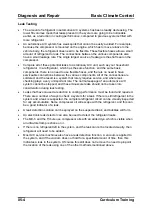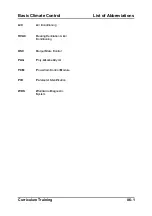
Heating System
Basic Climate Control
Thermostat
•
When starting a cold engine, the thermostat stays closed to ensure that the coolant flows
only through the ‘small circuit’. This ensures that the engine reaches its operating
temperature as quickly as possible, and that heat is available for the heater core to heat
up the air as quickly as possible. When the engine temperature exceeds a certain value,
the thermostat opens to allow the coolant to flow through the radiator (‘big circuit’). In this
way, the optimum engine temperature is maintained and overheating of the engine is
prevented.
Heater Core
•
The heater core has essentially the opposite function of the evaporator. The hot coolant
flowing through the tubes of the heater core releases its heat to the air passing through
the fins of the heater core. The fins, which are brazed to the tubes, allow for efficient
heat transfer between the hot coolant and the cool air. The air mix door will determine
how much of the airflow passes through the fins of the heater core, and accordingly how
much warmth will be transferred to the air. The control strategy is covered in depth in the
‘Advanced Climate Control’ course.
Water Pump
•
The water pump is driven by the engine and circulates the coolant through the system.
Radiator
•
The radiator functions just like the heater core, except that it is much larger to allow it to
release the engine heat to the air passing through the fins.
04-2 Curriculum
Training
Summary of Contents for CT-L1005
Page 1: ...Training Manual Basic Climate Control CT L1005...
Page 20: ...Fundamentals Basic Climate Control Notes 02 14 Curriculum Training...
Page 52: ...A C System Basic Climate Control Notes 03 32 Curriculum Training...
Page 66: ...List of Abbreviations Basic Climate Control Notes 06 2 Curriculum Training...













































